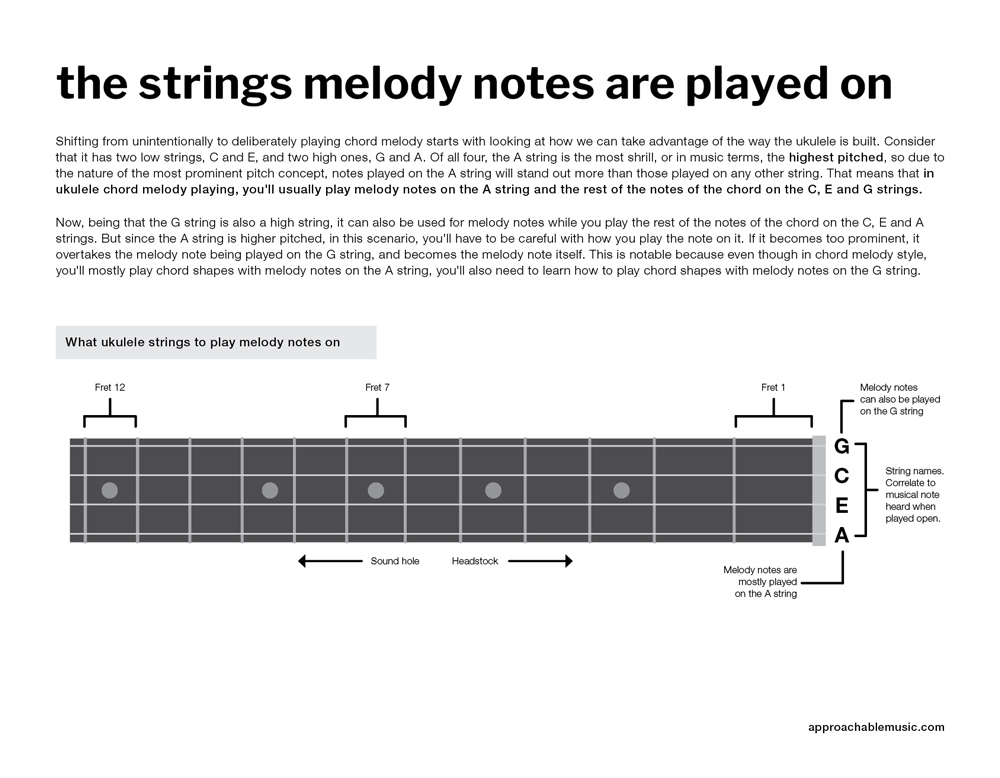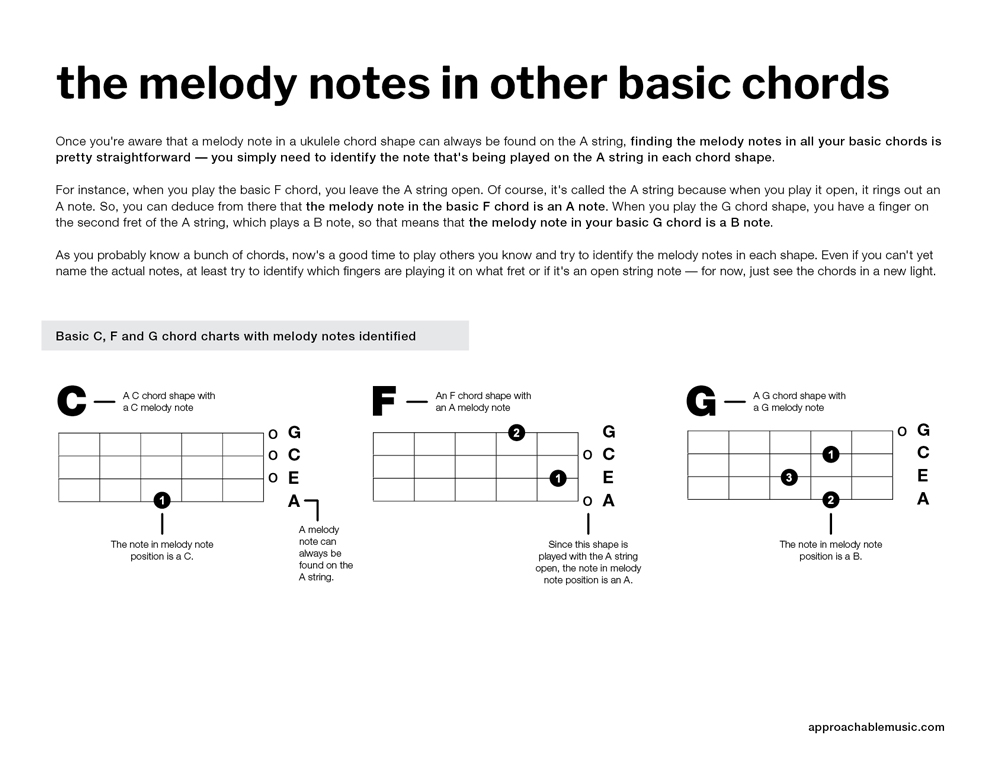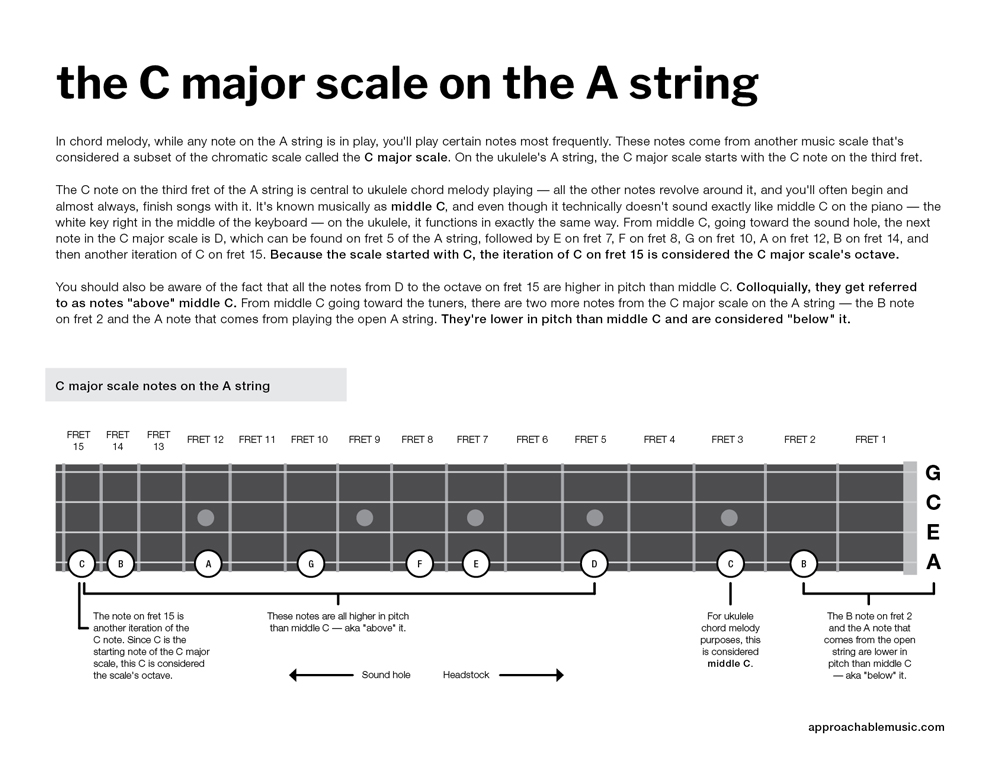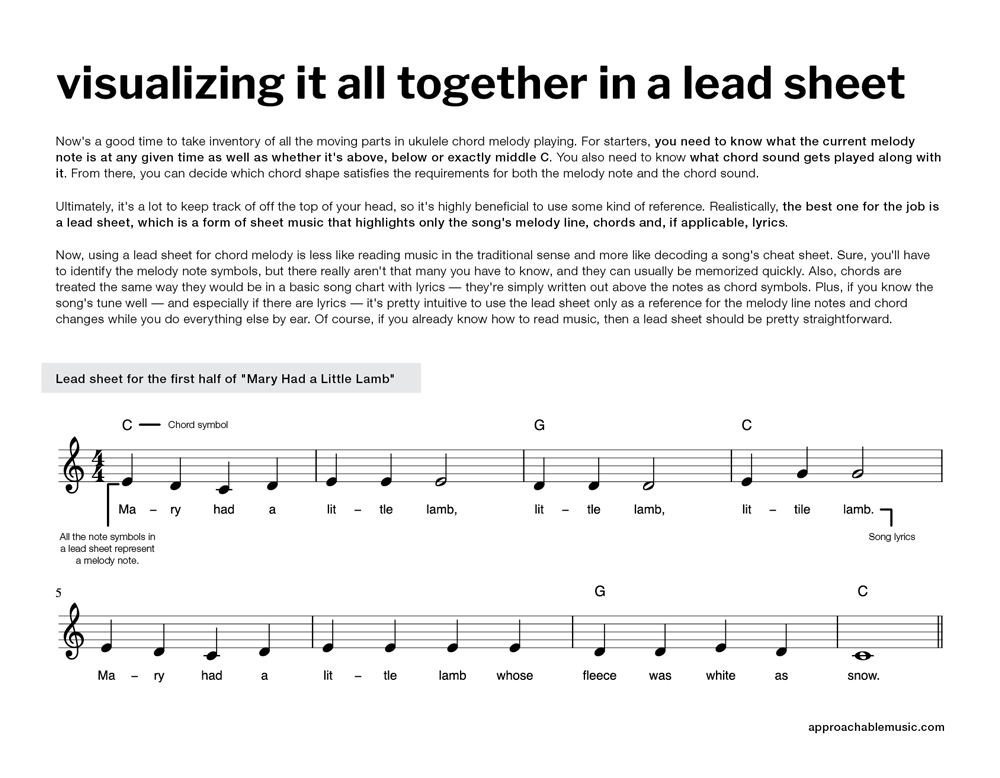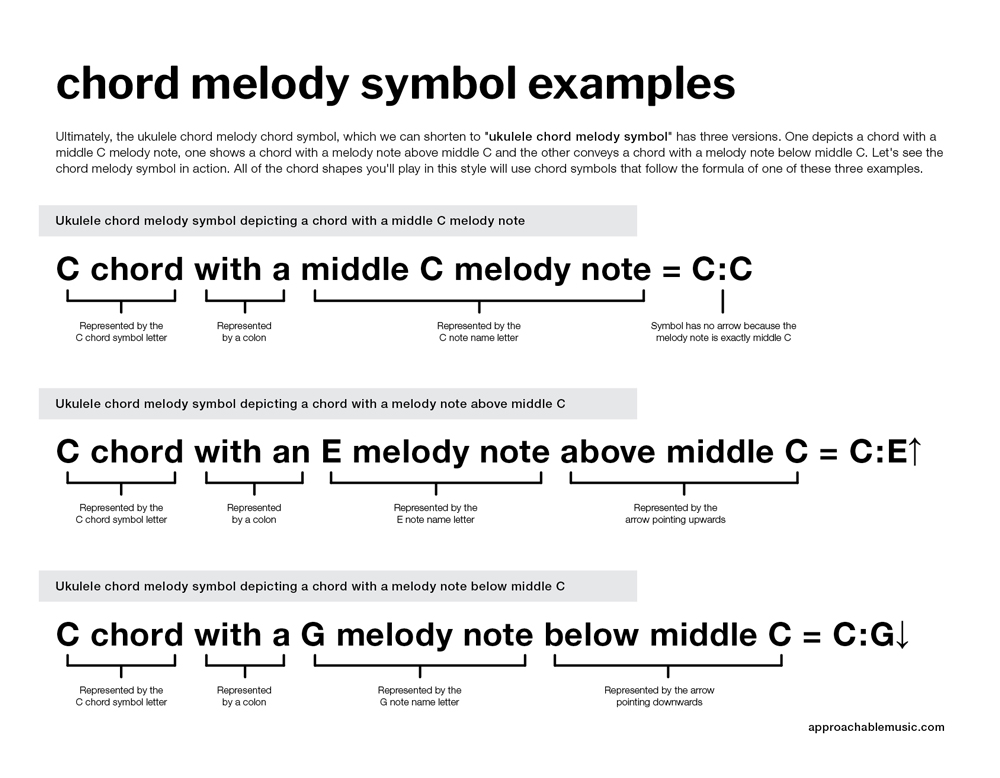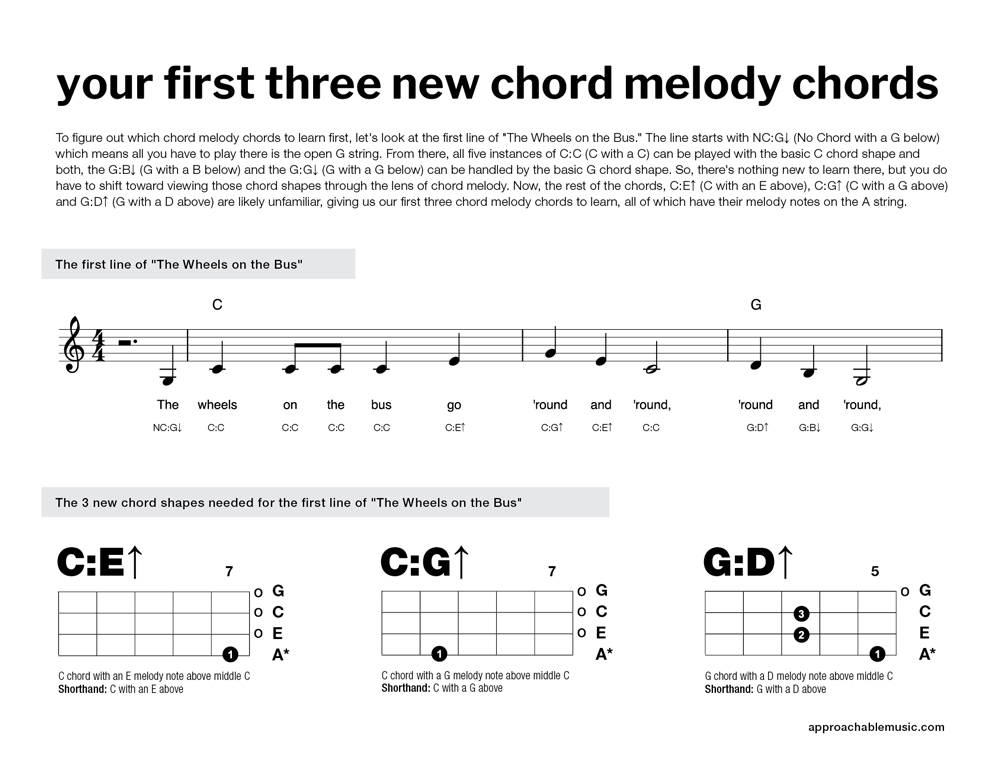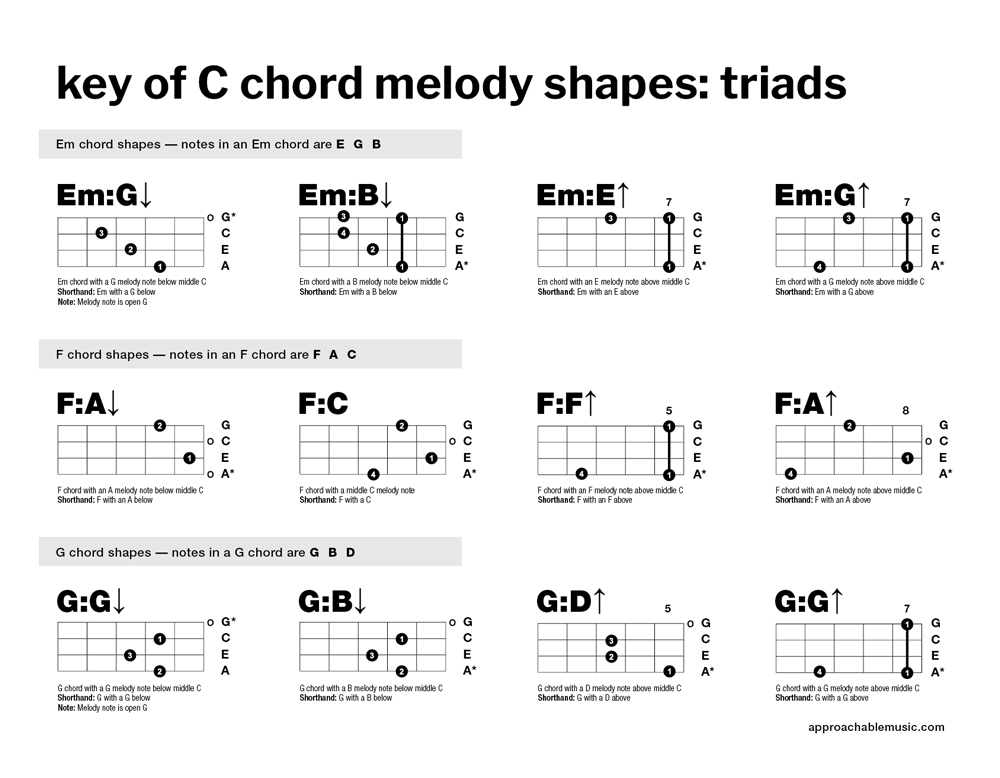MORE INFORMATION ABOUT THE BOOK
In general, most ukulele chord melody resources you'll find are for jazz tunes or songs from other complex genres, mostly because the style is usually perceived as only being for advanced players.
But the truth is, even beginners can learn chord melody as long as they start with approachable songs that revolve around basic chord changes.
You should know, though, that by dipping your toes into chord melody, you're actually entering the world of real musicianship, and realistically, the best way to gain traction with the style and eventually get good at it, is to simply embrace learning the music concepts associated with it.
That might seem scary now, but if you start with baby steps and go incrementally from there, in time, you'll find that music is nothing to be afraid of — it's all notes, chords and rhythms, along with how they're all written out for future use.
Of course, you could go the route of skipping the "music" part of chord melody, but ultimately, all of the ukulele's best secrets are kept at the crossroads of your own personal playing abilities, influences and yes, musical knowledge.
What Ukulele Chord Melody Looks Like
The instrument where chord melody is perhaps played most often is the piano, where it's typical that players play a song's chords with the left hand while playing the melody with the right. The piano, in fact, may be the instrument that's most intuitive for chord melody because the way it's usually played, both hands are totally independent of each other and also basically do the same thing — each one can both, set down fingers on the keys for notes and chords and also pulse out rhythmic patterns for those notes and chords. Since each hand is free to do whatever it wants, it makes it pretty straightforward to, for instance, pulse out the rhythm for a C chord with the left hand while at the same time, playing the individual notes of a melody on the right.
The ukulele, though, is different — your hands are dependent on each other. One hand, the chord hand, does the job of placing down fingers for notes or chords on the fingerboard, while the other, the rhythm hand, plays those notes and chords with strum or picking patterns. In general, you can't have one without the other, so in ukulele chord melody playing, the rhythm hand sticks to its job and is still responsible for the rhythm aspect of playing.
That means that the chord hand is tasked with setting down fingers for both, a song's chords and its melody at the same time, which is done by taking multiple versions of the same chord and changing them based on which melody note needs to be played at any given moment.
The Most Prominent Pitch Concept
Before learning to play chord melody on the ukulele, it's helpful to understand how chords and melody work together to form songs.
At it's core, a chord is simply a few notes all played at once, and by adding in a melody note, you're really just adding another to the pile.
The human ear works in a way that can make sense of the note pile by first, dialing into the most prominent pitch in the set — usually either the shrillest or the loudest. From there, the rest of the notes are considered background noise.
Music, of course, is essentially the study of how we can take advantage of how the ear works, and the most prominent pitch concept is central to how musicians organize chords and melody into all types of musical pieces.
In fact, all the melody notes in a song, which are collectively called the melody line, act as the most prominent pitch at the given moment they're in use, while the rest of the notes in the chord that are being played alongside each one is relegated to being background noise.
Now, it should be noted at this point that the ear also considers sung notes as prominent pitches, likely because people are trained from early on to listen to someone speaking to them. That's why when you sing even quietly while playing the ukulele, your voice comes through well, even when you play some pretty shrill notes in the chords you're strumming.
How Chords are Shaped in Ukulele Chord Melody
The most prominent pitch concept is key to understanding how the chord hand can play both, a song's chord progression and its melody line at the same time during chord melody playing on the ukulele.
Basically, to play each melody note in a song, you need to play a chord that's shaped in a way that features the melody note as its most prominent pitch.
Now, here's a good time to clarify the fact that it's not entirely accurate to refer to the ukulele chords that you know simply as "chords."
See, the word, "chord" is actually a music theory term that essentially means "the sound that's produced by multiple notes being played at the same time."
To produce chord sounds on an instrument, you use specific finger placements, called chord shapes. So, the ukulele "chords" we know are actually chord shapes that produce the chord sound we intend to play. That means that when we say, "we're playing a C chord," we're actually implying that we're using a chord shape to produce the C chord sound.
The difference between chords and chord shapes may seem subtle, but it's important for chord melody, which at it's core, requires you to switch through a variety of chord shapes that produce the same fundamental chord sound.
By the sheer nature of the way the ukulele is designed, when you play chord progressions, you also unintentionally play chord melody. Consider that if you play your basic C chord all by itself, one note sticks out above the rest — the one that you're playing on the third fret of the A string.
When you switch to an F chord, a different note stands out — the open A string — and if you play a G chord, it's the note that you're playing on the second fret of the A string. To take things a step further, when you play those three chords one after another, those prominent pitches result in a short melody line. Now, this little melody line itself isn't all that notable, but it's a representation of melody notes and chords played at the same time, which is exactly what we're trying to achieve with ukulele chord melody playing.
So, if it's already done unintentionally, that means we can also do it deliberately.
The Strings that Melody Notes are Played On
Shifting from unintentionally to deliberately playing chord melody starts with looking at how we can take advantage of the way the ukulele is built. Consider that it has two low strings, C and E, and two high ones, G and A. Of all four, the A string is the most shrill, or in music terms, the highest pitched, so due to the nature of the most prominent pitch concept, notes played on the A string will stand out more than those played on any other string. That means that in ukulele chord melody playing, you'll usually play melody notes on the A string and the rest of the notes of the chord on the C, E and G strings.
Now, being that the G string is also a high string, it can also be used for melody notes while you play the rest of the notes of the chord on the C, E and A strings. But since the A string is higher pitched, in this scenario, you'll have to be careful with how you play the note on it. If it becomes too prominent, it overtakes the melody note being played on the G string, and becomes the melody note itself. This is notable because even though in chord melody style, you'll mostly play chord shapes with melody notes on the A string, you'll also need to learn how to play chord shapes with melody notes on the G string.
Rethinking Ukulele Chord Shapes
If you've only played ukulele to sing songs, you might know little else about chord shapes other than the fact that when you see a chord symbol over a lyric, you play the one you know — basically, you see a C on the song chart, so you play the basic C chord shape you learned on day one.
But playing chord melody requires a deeper understanding of ukulele chords. See, for any chord symbol you encounter, there's theoretically, an endless possibility of chord shapes you can choose from to play it.
Now, within the context of singing songs, you're pretty much free to choose chord shapes based on arbitrary reasons, such as how easy they are to play or how good they sound as a backdrop to singing.
In fact, it's for these two reasons in particular why largely, everyone typically uses the same chords when they play most popular music songs.
With chord melody, though, you choose chord shapes not arbitrarily, but based on the melody note that's being called for you to play. That means that at the very least — and to get started — in every chord shape you play, you have to be able to identify the melody note by name.
However, if you really want to get good at playing chord melody style, you'll want to start thinking of "ukulele chords" less as one chord shape that can be used to play one chord sound and more as one chord sound that can be played in a variety of shapes.
This eventually leads you to the importance of knowing not only what the melody note is in a given chord shape, but also what the rest of the notes are, if only on a vague level. Ultimately, when you begin looking at a chord as a collection of notes that each do its part in chord melody, you start setting yourself up for being able to find chord shapes that create its sound all over the fretboard by yourself on the fly, and really, the sky's the limit from there.
A Plan for Learning Ukulele Chord Melody Chords
When you account for all the combinations of chord sounds and melody notes that result from the 14 most common chords in the key of C, there are over 50 possible chord shapes that can be used in ukulele chord melody playing. Some of these are the basic chords used for song playing, which just need to be translated to chord melody. From there, it's probably best to learn new chords as they come up in songs — some you'll use often, and others, hardly ever.
Ukulele Chord Melody and Strumming
Even if you're an experienced ukulele player, one of the most challenging aspects of playing chord melody is figuring out how to apply a strum to it. But the thing is, playing rhythm well in chord melody is an even more advanced skill than simply being able to move through the constantly changing chord shapes. So, let's take that layer of complexity out all together and learn a strumming method that not only makes it fairly straightforward to start playing songs in the chord melody style right away, but can also serve as the foundation for more advanced chord melody rhythm techniques.
The most intuitive way to get started with ukulele chord melody rhythm is to strum one downstroke per lyric syllable while playing nothing during the pauses in the song. See, lyrics are simply a representation of a song's melody notes in word syllables, and the one-downstroke-per-syllable strum allows you to change chords as the melody notes require you to in the most natural way possible — if you think about it, you never change chords on an upstroke while you're singing songs, so you wouldn't do it that way in chord melody either.
In the end, your success with chord melody playing really depends on the strength of your fundamental ukulele skills.
Having blind spots when it comes to the basic chords, how to strum or how to transpose will simply make gaining traction with ukulele chord melody style more challenging. If you need guidance on any of these skills, click here for more PDF guides.

